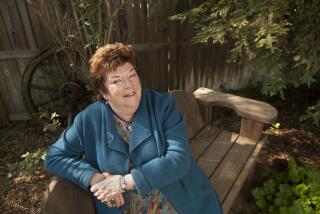The Mathematics of Pride : ESCALANTE The Best Teacher in America <i> by Jay Mathews (Henry Holt: $19.95; 322 pp.; 0-8050-0450-5) </i>
- Share via
The name Jaime Escalante has been emblazoned recently in headlines, first through the film, “Stand and Deliver,” that made him a star of sorts, and then during the presidential debates when George Bush dramatically singled out Escalante, when asked about his heroes. Now, Jay Mathews, in a timely and wonderfully written account, gives us a closer, more revealng look at the man behind the legend.
Mathews, an award-winning reporter, has a nose for a good story. In 1982, he was attracted to Garfield High through news reports that students in this East Los Angeles school were accused of cheating on an Advanced Placement calculus exam. What struck Mathews, however, was not the accusations, but that a school like Garfield, with a student body drawn from a poor Latino community, could find 18 students to enroll in what was equivalent to a tough college-level course. His investigations led him to Escalante and five years of intimate contact with the Garfield community.
In the first portion of the book, Mathews interweaves sketches of the early lives of his three chief protagonists in the Garfield miracle: Escalante, principal Henry Gradillas, and a younger member of the math department, Benjamin Soto Jimenez.
We learn that Escalante grew up in Bolivia, becoming one of the top teachers in La Paz at an early age. He and his family immigrated to Southern California because of chronic financial worries (the United States is not alone in paying its teachers poorly), but before being allowed to teach in California schools, he had to get an American college degree.
After working as a cook to support his family while attending night school, Escalante, urged on by his wife, Fabiola Tapia, finally, in his mid-’40s, returned to teaching. Ironically, his baptism into the depressing waters of Garfield left him discouraged--almost ready to quit after just one year.
Mathews captures the humanity of this saga, breathing life into the students, admnistrators, and teachers who make up Garfield High. Escalante himself is presented as a man driven by motivations that are both noble and complex.
I assumed from the hyped-up subtitle of the book--”the Best Teacher in America”--that Escalante would be portrayed in heroic proportions, and in a way he is. But Mathews is a good reporter, and paints the central figure of this book from every angle, warts and all.
Scattered throughout is an entertaining record of Escalante-isms in the classroom, the catch phrases and nicknames, the goads, gimmicks, and insults that infuriate, entertain, and ultimately convince his students they can make it.
We are also treated to disagreements with colleagues who oppose Escalante’s aggressive classroom methods. For example, one counselor complains that Escalante drives his students too hard in calculus at the expense of other areas. Escalante’s reply is that “They don’t understand that these kids need the competition. . . . They’re lazy, most of them. You give them more time, they go home and watch television, or ride their motorcycles, or go to McDonald’s. . . . But if they got through calculus, they have something.”
There is something to be said for both arguments, of course. But Mathews, ever the clear-eyed reporter, refrains from taking sides, leaving the reader to weigh the merits of contesting views.
Threaded throughout this compelling narrative is a carefully balanced reporting of life in an urban school. Mathews is less interested in relating horror stories (although there are episodes that cause even the most optimistic reader almost to lose hope), choosing instead to concentrate on the daily lives of average students and on the low expectations that trap them in a self-fulfilling prophecy of failure.
Regarding the controversy over cheating, the author presents all the facts as fully as they can be determined. He makes no effort to gloss over evidence suggesting that the similar test results in 1982 on one particular question were hardly the result of chance. On the other hand, Mathews underscores the point that when the examinations were retaken, the students did exceptionally well.
The author reminds the reader that the cloud of doubt surrounding “cheating” should not distract from the larger lessons to be learned. Here are students who were going nowhere. Because of the energy and will of a few dedicated teachers and administrators, things did, in fact, get better.
Again, Mathews is a reporter, not a reformer. But by painstakingly accumulating facts and presenting them with power, the reader begins to understand why students fail and what changes must be introduced if we hope to save innercity schools.
Time and time again, we are brought to share Escalante’s frustrations with the system, the lax administrators, and bored students. We cheer his efforts to instill acceptable codes of behavior, rid the school of childishly simple textbooks, and make his students want to learn.
At the same time, Mathews drives home the point that simple formulas for school reform simply will not work; that raising standards is not enough; that one man cannot do it all alone. Schooling is a human enterprise, one that reaches beyond academic requirements and scores on a national exam. If we are to create an atmosphere where teaching is respected and learning prized, everyone in the school community must be involved--parents, administrators, students, and teachers.
“Escalante” vividly underscores the point that we are facing not merely a school problem, but a family and youth problem in this nation. And, if our educational system is to succeed, ways must be found to touch students’ lives. A course in higher mathematics alone may seem an unlikely way to do it, but “Escalante” offers undeniable proof of its effectiveness in raising the self-esteem of students.
While Americans talk about providing quality education for all children, far too many, both in and out of the nation’s schools, do not believe this objective can be reached. It is unacceptable to perpetuate a system in which failure is commonplace and students are passed along in an all-too-familiar pattern that divides the winners and the losers.
Our country must reaffirm equality of opportunity and give it meaning in every classroom. “Escalante’s” reassuring message is that, with high hopes and an uncompromising commitment to high standards, students, regardless of their backgrounds, can academically and socially succeed.
More to Read
Sign up for our Book Club newsletter
Get the latest news, events and more from the Los Angeles Times Book Club, and help us get L.A. reading and talking.
You may occasionally receive promotional content from the Los Angeles Times.









